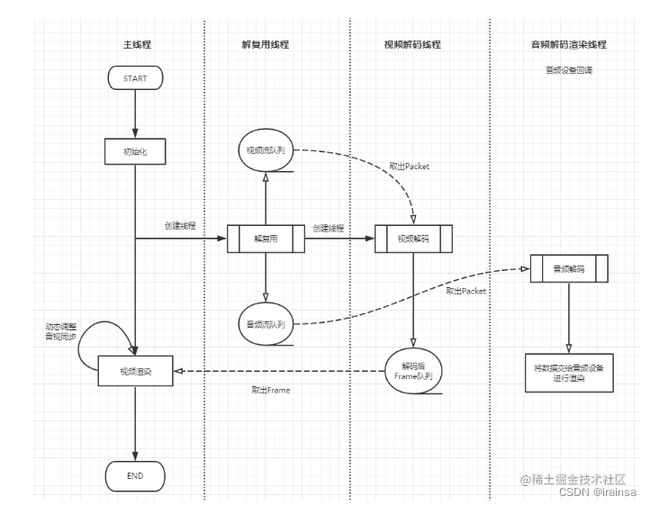FFmpeg+SDL2实现简易音视频同步播放器
SDL2文章列表
SDL系列讲解 视频渲染入门_irainsa的博客-CSDN博客
SDL 事件处理_irainsa的博客-CSDN博客
SDL 纹理渲染_irainsa的博客-CSDN博客
SDL2 PCM音频播放_irainsa的博客-CSDN博客
FFmpeg+SDL2实现视频流播放_irainsa的博客-CSDN博客
FFmpeg+SDL2实现音频流播放_irainsa的博客-CSDN博客
FFmpeg音视频同步_irainsa的博客-CSDN博客
经过前面一系列的SDL2学习,终于到最后实现一个完整的简易播放器了。
线程模型
这是实现的简易播放器的线程模型,通过这张图再结合我们之前博客中学习的内容,基本可以了解播放器的一个整体运行流程。具体代码也是根据这张图来实现。
重要结构体
VideoState
整个播放器中最重要的结构体,解复用、解码、音视频同步、渲染相关参数都在该结构体中,它贯穿了整个播放流程。
typedef struct VideoState {
char filename[1024]; // 文件名称
AVFormatContext *pFormatCtx; // 上下文
int videoStream, audioStream; //音视频流index
同步相关
double audio_clock;
double frame_timer;
double frame_last_pts;
double frame_last_delay;
double video_clock;
double video_current_pts;
int64_t video_current_pts_time;
//音频相关
AVStream *audio_st; // 音频流
AVCodecContext *audio_ctx; // 音频解码上下文
PacketQueue audioq; // 音频队列
uint8_t audio_buf[(MAX_AUDIO_FRAME_SIZE * 3) / 2]; // 音频缓存
unsigned int audio_buf_size;
unsigned int audio_buf_index;
AVFrame audio_frame; // 音频帧
AVPacket audio_pkt; // 音频包
uint8_t *audio_pkt_data;
int audio_pkt_size;
struct SwrContext *audio_swr_ctx; // 音频重采样
//video
AVStream *video_st; // 视频流
AVCodecContext *video_ctx; // 视频流解码上下文
PacketQueue videoq; // 视频流队列
VideoPicture pictq[VIDEO_PICTURE_QUEUE_SIZE]; // 解码后视频帧数组
int pictq_size, pictq_rindex, pictq_windex;
SDL_mutex *pictq_mutex;
SDL_cond *pictq_cond;
SDL_Thread *parse_tid; // 解复用线程
SDL_Thread *video_tid;// 视频解码线程
int quit; // 退出标记位
} VideoState;PacketQueue
解复用后音视频packet保存队列
typedef struct PacketQueue {
AVPacketList *first_pkt, *last_pkt;
int nb_packets;
int size;
SDL_mutex *mutex;
SDL_cond *cond;
} PacketQueue;VideoPicture
解码后视频帧
typedef struct VideoPicture {
AVFrame *frame;
int width, height;
double pts; // 音视频同步后视频帧应该播放的时间
} VideoPicture;具体代码
Main
- 初始化
- 创建定时器,定时视频帧的刷新
- 创建解复用线程
- 等待事件
int WinMain(int argc, char *argv[]) {
char *file = "C:\\Users\\lenovo\\Desktop\\IMG_5950.mp4";
SDL_Event event;
VideoState *is;
is = av_mallocz(sizeof(VideoState));
if (SDL_Init(SDL_INIT_VIDEO | SDL_INIT_AUDIO | SDL_INIT_TIMER)) {
fprintf(stderr, "Could not initialize SDL - %s\n", SDL_GetError());
exit(1);
}
//创建SDL Window
win = SDL_CreateWindow("Media Player",
100,
100,
640, 480,
SDL_WINDOW_RESIZABLE);
if (!win) {
fprintf(stderr, "SDL_CreateWindow error,exit!", SDL_GetError());
exit(1);
}
renderer = SDL_CreateRenderer(win, -1, 0);
text_mutex = SDL_CreateMutex();
strlcpy(is->filename, file, sizeof(is->filename));
is->pictq_mutex = SDL_CreateMutex();
is->pictq_cond = SDL_CreateCond();
// 定时刷新器,主要用来控制视频的刷新
schedule_refresh(is, 40);
// 创建解复用线程
is->parse_tid = SDL_CreateThread(demux_thread, "demux_thread", is);
if (!is->parse_tid) {
av_free(is);
return -1;
}
for (;;) {
// 等待SDL事件,否则阻塞
SDL_WaitEvent(&event);
switch (event.type) {
case FF_QUIT_EVENT:
case SDL_QUIT: // 退出
is->quit = 1;
goto Destroy;
case SDL_KEYDOWN:// ESC退出
if (event.key.keysym.sym == SDLK_ESCAPE) {
is->quit = 1;
goto Destroy;
}
break;
case FF_REFRESH_EVENT: // 定时器刷新事件
video_refresh_timer(event.user.data1);
break;
default:
break;
}
}
// 退出
Destroy:
SDL_Quit();
return 0;
}解复用
- 打开文件
- 找到音视频流
- 打开音频、视频流,创建视频解码线程,准备解码
- 读取packet,将音视频packet分别放入队列中,等待解码线程取出
int demux_thread(void *arg) {
if ((err_code = avformat_open_input(&pFormatCtx, is->filename, NULL, NULL)) < 0) {
av_strerror(err_code, errors, 1024);
return -1;
}
// Find the first video stream
for (i = 0; i < pFormatCtx->nb_streams; i++) {
if (pFormatCtx->streams[i]->codecpar->codec_type == AVMEDIA_TYPE_VIDEO &&
video_index < 0) {
video_index = i;
}
if (pFormatCtx->streams[i]->codecpar->codec_type == AVMEDIA_TYPE_AUDIO &&
audio_index < 0) {
audio_index = i;
}
}
// 打开音频流,创建解码器,配置参数
if (audio_index >= 0) {
stream_component_open(is, audio_index);
}
// 打开视频流,创建解码器,创建解码线程
if (video_index >= 0) {
stream_component_open(is, video_index);
// video_tid = SDL_CreateThread(decode_video_thread, "decode_video_thread", is);
}
for (;;) {
if (av_read_frame(is->pFormatCtx, packet) < 0) {
if (is->pFormatCtx->pb->error == 0) {
SDL_Delay(100); /* no error; wait for user input */
continue;
} else {
break;
}
}
// 将packet存入队列中
if (packet->stream_index == is->videoStream) {
packet_queue_put(&is->videoq, packet);
} else if (packet->stream_index == is->audioStream) {
packet_queue_put(&is->audioq, packet);
} else {
av_packet_unref(packet);
}
}
return 0;
}视频解码
- 从队列中取出视频packet
- 解码,同步
- 加码后Frame存入数组,等待视频渲染
视频解码
int decode_video_thread(void *arg) {
VideoState *is = (VideoState *) arg;
AVPacket pkt1, *packet = &pkt1;
AVFrame *pFrame;
double pts;
pFrame = av_frame_alloc();
for (;;) {
// 从视频队列中取出packet
if (packet_queue_get(&is->videoq, packet, 1) < 0) {
break;
}
// 解码
avcodec_send_packet(is->video_ctx, packet);
while (avcodec_receive_frame(is->video_ctx, pFrame) == 0) {
if ((pts = pFrame->best_effort_timestamp) != AV_NOPTS_VALUE) {
} else {
pts = 0;
}
pts *= av_q2d(is->video_st->time_base);
// 同步
pts = synchronize_video(is, pFrame, pts);
if (queue_picture(is, pFrame, pts) < 0) {
break;
}
av_packet_unref(packet);
}
}
av_frame_free(&pFrame);
return 0;
}音频解码
音频设备回调
void audio_callback(void *userdata, Uint8 *stream, int len) {
VideoState *is = (VideoState *) userdata;
int len1, audio_size;
double pts;
SDL_memset(stream, 0, len);
while (len > 0) {
if (is->audio_buf_index >= is->audio_buf_size) {
// 音频解码
audio_size = audio_decode_frame(is, is->audio_buf, sizeof(is->audio_buf), &pts);
if (audio_size < 0) {
// 音频解码错误,播放静音
is->audio_buf_size = 1024 * 2 * 2;
memset(is->audio_buf, 0, is->audio_buf_size);
} else {
is->audio_buf_size = audio_size;
}
is->audio_buf_index = 0;
}
len1 = is->audio_buf_size - is->audio_buf_index;
if (len1 > len)
len1 = len;
// 混音播放
SDL_MixAudio(stream, (uint8_t *) is->audio_buf + is->audio_buf_index, len1, SDL_MIX_MAXVOLUME);
len -= len1;
stream += len1;
is->audio_buf_index += len1;
}
}视频刷新播放
视频刷新播放,并预测下一帧的播放时间,设置新的定时器
void video_refresh_timer(void *userdata) {
VideoState *is = (VideoState *) userdata;
VideoPicture *vp;
double actual_delay, delay, sync_threshold, ref_clock, diff;
if (is->video_st) {
if (is->pictq_size == 0) {
schedule_refresh(is, 1);
} else {
// 从数组中取出一帧视频帧
vp = &is->pictq[is->pictq_rindex];
is->video_current_pts = vp->pts;
is->video_current_pts_time = av_gettime();
// 当前Frame时间减去上一帧的时间,获取两帧间的时差
delay = vp->pts - is->frame_last_pts;
if (delay <= 0 || delay >= 1.0) {
// 延时小于0或大于1秒(太长)都是错误的,将延时时间设置为上一次的延时时间
delay = is->frame_last_delay;
}
// 保存延时和PTS,等待下次使用
is->frame_last_delay = delay;
is->frame_last_pts = vp->pts;
// 获取音频Audio_Clock
ref_clock = get_audio_clock(is);
// 得到当前PTS和Audio_Clock的差值
diff = vp->pts - ref_clock;
// AV_SYNC_THRESHOLD 最小刷新时间
sync_threshold = (delay > AV_SYNC_THRESHOLD) ? delay : AV_SYNC_THRESHOLD;
// diff小于非同步阈值,可以进行同步
if (fabs(diff) < AV_NOSYNC_THRESHOLD) {
if (diff <= -sync_threshold) {
// 视频时间在音频时间之前,应该让视频尽快播放
delay = 0;
} else if (diff >= sync_threshold) {
// 视频时间在音频时间之后,应该让视频延迟播放
delay = 2 * delay;
}
}
is->frame_timer += delay;
// 最终真正要延时的时间
actual_delay = is->frame_timer - (av_gettime() / 1000000.0);
if (actual_delay < 0.010) {
// 延时时间过小就设置最小值
actual_delay = 0.010;
}
// 根据延时时间重新设置定时器,刷新视频
schedule_refresh(is, (int) (actual_delay * 1000 + 0.5));
// 视频帧显示
video_display(is);
// 更新视频帧数组下标
if (++is->pictq_rindex == VIDEO_PICTURE_QUEUE_SIZE) {
is->pictq_rindex = 0;
}
SDL_LockMutex(is->pictq_mutex);
// 视频帧数组减一
is->pictq_size--;
SDL_CondSignal(is->pictq_cond);
SDL_UnlockMutex(is->pictq_mutex);
}
} else {
schedule_refresh(is, 100);
}
}大体的流程就是这样了,相比之前的Demo复杂度会高不少,但是所有的知识在前面的博客中都有涉及,在博客中也讲不了什么东西,还是直接自己运行,再去看代码会更好,理清流程,整个播放器的代码也不会很难看懂,这里附上源码 Github-SimplePlay
学习音视频推荐:
【腾讯文档】FFmpegWebRTCRTMPRTSPHLSRTP播放器-音视频流媒体高级开发-资料领取
https://docs.qq.com/doc/DYU5ORlBOdkpCUkNx![]() https://docs.qq.com/doc/DYU5ORlBOdkpCUkNx
https://docs.qq.com/doc/DYU5ORlBOdkpCUkNx
